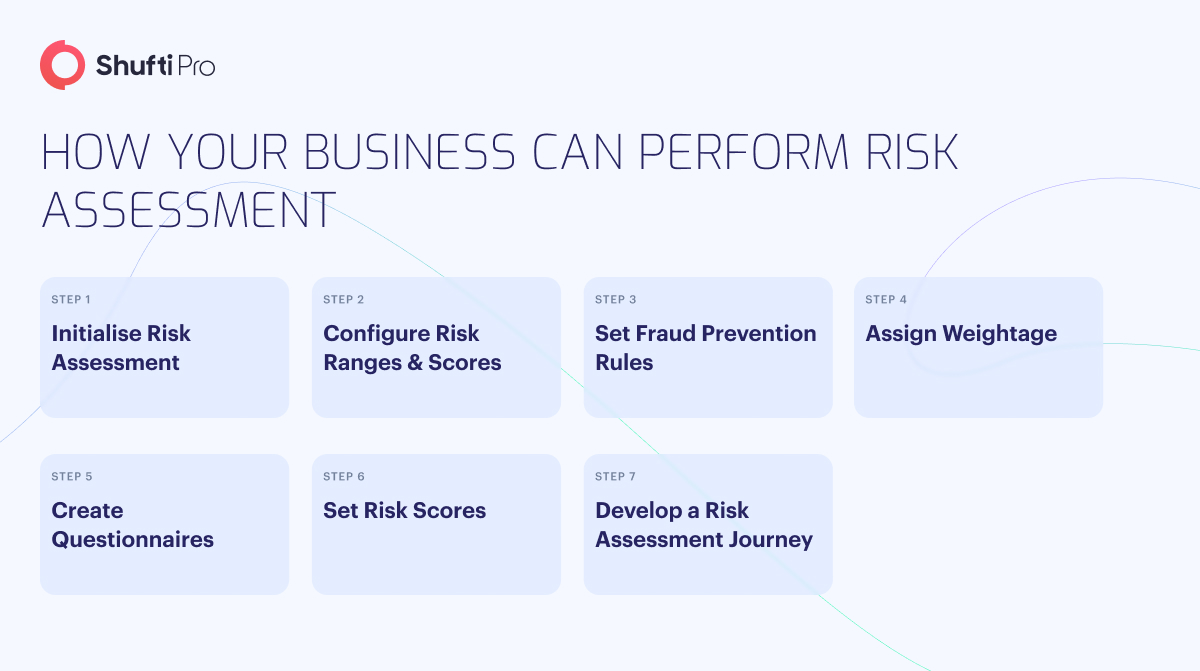Top 6 Practises For Your Business To Pinpoint Key Risk Areas

As global industries continue to evolve and digitise, customer risk assessment has become a critical aspect of business compliance worldwide. With the increase in digital transactions and remote onboarding, it is critical for companies to understand the complexities of the risk assessment procedures and how it can help them to fight fraud whilst meeting KYC AML compliance. Failing to perform adequate risk assessment results in non-compliance and can cost businesses billions of dollars in fines. Financial firms and banks were amongst the most penalised in 2022, with almost $5bn for “anti-money laundering” infractions, breaching sanctions, and failings in their “know your customer” system.
This blog aims to shed light on the complexities of risk assessment and provide detailed insight on its importance for your business.
Customer Risk Assessment – A Short Overview
Risk assessment is a significant part of managing the risk of financial crime which has continuously changed with modernisation; its origin being traced to the turn of the century whereby the first anti-money laundering regulation was introduced.
As the global financial industry expanded, banks have to consider the potential risk associated with clients from various industries and countries, increasing the importance of conducting a risk assessment. Moreover, the exponential rise in financial crimes and identity theft has further stressed the significance of customer risk assessment, as criminals are becoming more sophisticated in finding new ways to exploit businesses’ security systems.
Over the years, various regulatory obligations have emerged that have impacted the development of customer risk assessment. For instance, the USA Patriot Act, introduced after the world trade centre tragedy, further broadened the scope of anti-money laundering and increased the focus on customer risk assessment. The EU also emerged with the 4th, 5th, and 6th Anti-money Laundering Directives that have played a vital role in forming risk assessment standards.
In light of these developments, risk assessment has become an imperative tool in the fight against money laundering and other financial crimes, whilst continuing to evolve to meet the changing demands of regulatory obligations and the financial industry.
Factors to Consider in Your Customer Risk Assessment
As part of a risk assessment strategy, businesses need to consider a series of risk factors, monitor their customers against them, and have defined pathways in place upon risk identification.
Specifically, these are:
- Regulatory Risk: Failure to conduct or meet Know Your Customer (KYC) and Anti-Money Laundering (AML) checks on clients is a regulatory risk. This can put the business at stake whilst exposing them to the risk of money laundering and financial crimes, leading to penalties and sanctions.
- Customer Risk: Businesses must identify the type of customer that can pose a risk. Are they private individuals, or are they PEP? Who is the UBO, and which company are they associated with? And the list of checks goes on.
- Product Risk: This factor considers whether your business’s product or service can potentially enable money laundering or other financial crimes. The scope of what a customer can do with the product can vary significantly.
- Geographical Risk: the businesses need to determine the customer’s origin or the country in which the company operates. In this, the areas or countries on the sanction lists need to be filtered out as customers from such countries can pose a higher risk of financial crimes.
- Delivery Channel Risk: this factor considers how the client transacts with your businesses and assesses the environment that adds more risk. For instance, a customer accessing the servers via API or mobile banking application may be more likely to pose a risk than a client who physically visited the branch.

Top 6 Practices for Developing Risk Assessment Program
Conducting a proper risk assessment is vital to effective AML and KYC programs.
By using best practices, financial firms and banks can limit the risk of losing money, improve their brand image, make operations fool-proof, and ensure the safety of their customers.
- Conducting Due Diligence: Conducting comprehensive due diligence is vital for businesses to ensure error-free & reliable risk assessment, which further helps them to develop accurate customer risk profiles. This must include customer background screening, gathering financial information, and other PII.
- Regular Monitoring: Monitoring customer transactions is essential for detecting any potential risk of crimes. This should include real-time transaction monitoring and periodic reviews of customers’ profiles.
- Using Automated Solutions: Using automated customer risk assessment services can help businesses increase the effectiveness of the whole process. These solutions are powered by sophisticated technologies that provide monitoring and potential risk alerts in real-time.
- Incorporating a Risk-Based Approach: This strategy prioritises and manages customer risk profile. This involves assigning a risk score to each customer depending upon the risk they may pose whilst tailoring the level of customer due diligence as per regulatory requirements.
- Keeping up-to-date with Regulatory Changes: It is essential to stay informed of any changes to AML and KYC regulations and to update risk assessment procedures accordingly. This helps ensure compliance with these regulations and reduces the risk of penalties.
- Implementing a Robust Compliance Program: This includes practical customer risk assessment is crucial for protecting against financial losses and maintaining compliance with AML and KYC regulations.
How Shufti’s Risk Assessment can Help Your Business
Identifying and fighting financial crimes is essential for digital businesses and is the right time for enterprises to invest in risk assessment solutions. It’s an ideal way to counter money launderers and other financial criminals.
Shufti’s customer risk assessment service is perfect for any type of business, aiming to provide its customers with a risk-free experience. Our solution ensures your business remains compliant and mitigates the risk of losing money or damaging your business reputation. Shufti’s risk assessment holds the potential to verify customers against rigid KYC and AML checks with 99% accurate results.
Still confused? Learn more about our risk assessment service and how it can help your businesses in the fight for security in the digital economy.











